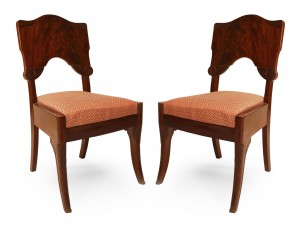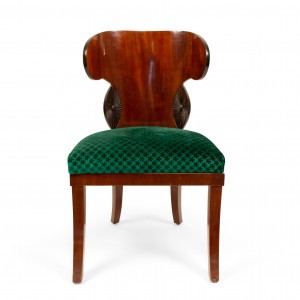X
{{ modalTitle }}
PLEASE FILL IN THE REQUIRED FIELDS.X
X
{{ modalTitle }}
Choose one of the options below.X
ITEM SUCCESSFULLY
ADDED TO PROJECT
Set of 6 Russian Neo-Classic Mahogany Upholstered Dining Chairs
 Russian
Russian Russian
Russian Seating
Seating Side Chairs
Side Chairs
Newel Warehouse
32-00 Skillman Ave
Long Island City NY - 11101
 (212) 758-1970
(212) 758-1970
Set of 6 Russian Neo-Classic Mahogany Upholstered Dining Chairs

Newel Warehouse
32-00 Skillman Ave
Long Island City NY - 11101
 (212) 758-1970
(212) 758-1970
 Seating
Seating Side Chairs
Side ChairsMahogany
Mahogany is a straight grained hard wood with silky texture, ranging in color from dark brown to red. Furniture made from mahogany became popular in Britain from Mid-18th Century on, spreading throughout Europe.
Veneer
A wood finishing technique in which thin sheet of fine wood is applied to a the surface of a coarser wood or other structural material for decoration. Veneer is used to give furniture pieces a finer, more pleasing appearance. It was first used in ancient Egypt, classical Greece, and Rome, but did not appear again until the 17th Century in the Netherlands.
Neo-classic
Neo-classic refers to the second revival of classic design for interior decoration in the 18th century. This style was inspired by excavations of Pompeii and Herculaneum that begun in 1738. Common motifs include dolphins, lyres, and urns.
Mahogany
Mahogany is a straight grained hard wood with silky texture, ranging in color from dark brown to red. Furniture made from mahogany became popular in Britain from Mid-18th Century on, spreading throughout Europe.
Veneer
A wood finishing technique in which thin sheet of fine wood is applied to a the surface of a coarser wood or other structural material for decoration. Veneer is used to give furniture pieces a finer, more pleasing appearance. It was first used in ancient Egypt, classical Greece, and Rome, but did not appear again until the 17th Century in the Netherlands.
Neo-classic
Neo-classic refers to the second revival of classic design for interior decoration in the 18th century. This style was inspired by excavations of Pompeii and Herculaneum that begun in 1738. Common motifs include dolphins, lyres, and urns.
Mahogany
Mahogany is a straight grained hard wood with silky texture, ranging in color from dark brown to red. Furniture made from mahogany became popular in Britain from Mid-18th Century on, spreading throughout Europe.
Veneer
A wood finishing technique in which thin sheet of fine wood is applied to a the surface of a coarser wood or other structural material for decoration. Veneer is used to give furniture pieces a finer, more pleasing appearance. It was first used in ancient Egypt, classical Greece, and Rome, but did not appear again until the 17th Century in the Netherlands.
Neo-classic
Neo-classic refers to the second revival of classic design for interior decoration in the 18th century. This style was inspired by excavations of Pompeii and Herculaneum that begun in 1738. Common motifs include dolphins, lyres, and urns.





















